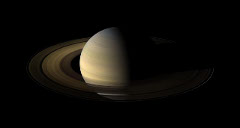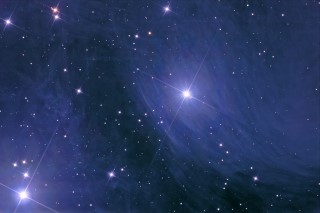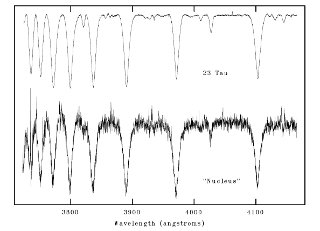Saturn: View of Saturn and it's rings from Cassini, taken just after Saturn equinox on August 12, 2009. The Sun is just above the plane of the rings illuminating portions of the planet, rings, and a few of its moons.
Credit: NASA/JPL/Space Science Institute
While stars are the main long-lasting sources of visible light in space, the light that they emit can sometimes reflect off other objects. The most noticeable example is the Moon, which reflects the light from the Sun. The colors and spectra of such objects are the same as those of the primary source of light, for instance the Moon has a color similar to that of the Sun and the same spectrum. The Moon does not generate its own light, and the amount of the surface we see depends on the angle from which we are observing it. When the Moon is between the Earth and the Sun, we cannot see the Moon at all.
The light from other planets in the solar system is also reflected light from the Sun. All planets reflect the light from their star, which is the only way that we can see them with our eyes. However, most planets are so far away that the light they reflect is overwhelmed by the direct light shining from their star. Maybe one day an astronomer will be able to figure out another way to see these planets using visible light.
There is a class of nebulae in the galaxy that only reflects light, and these are naturally named reflection nebulae. In these cases light is reflected off small dust particles like small mirrors, changing its direction and allowing us to see the clouds containing the dust. As with the case of the planets and their host star, the reflected light appears to be much fainter than the light from the original source.
Barnard's Merope Nebula: Known as Barnard's Merope Nebula because it was first identified by E. E. Barnard in 1891 and is near the bright star Merope in the Pleiades nebulosity. It was later cataloged as IC 349.
Credit: Image courtesy Johannes Schedler / panther-observatory
Merope Spectrum: The top spectrum is of the star Merope, one of the Seven Sisters in the constellation known as the Pleiades. The bottom spectrum is of the light reflected off of dust grains behind the nebula, back to Earth. Only a tiny portion of the nebula from the accompanying image was used to take this image. The spectra are identical. This type of nebula is called a reflection nebula. The nebula is much fainter (by a factor of 1 million per square arcsec of sky) than the star, so that even with an exposure of 18,000 seconds, the signal is much weaker than that of the star, the exposure for which, with the same instrument, is only a few seconds. The relatively weak signal accounts for the fluctuations (noise) in the nebular spectrum. The spectra were recorded using a high resolution spectrograph fed by a 36-inch telescope (the Kitt Peak National Observatory Coulde Feed). For more information about this spectrum, see Barentine, John C. and Esquerdo, Gilbert A. 1999, ApJ, 117, 1402.
Credit: Spectrum courtesy J. Barentine and G. Esquedero / American Astronomical Society




